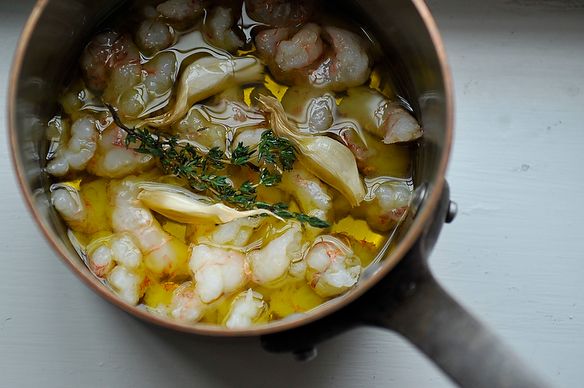
A New Way to Dinner, co-authored by Food52's founders Amanda Hesser and Merrill Stubbs, is an indispensable playbook for stress-free meal-planning (hint: cook foundational dishes on the weekend and mix and match ‘em through the week).
Order nowPopular on Food52
46 Comments
Tasha
April 8, 2015
Is the intention to submerge the fish (so 1/8 of an inch above the 'top' if the fish)..just wondering if I am reading this right as it would seem that you then wouldn't need to baste...hope and that makes sense :)
Mary
January 3, 2014
I just discovered this fantastic way to poach seafood. Some recipes call for just a few minutes of poaching and some said the fish needed 1 to 1 1/2 hours. I poached cod at 200 degrees for one hour and it was perfect. Season the fish with salt and pepper and lay it on a bed of thinly sliced Meyer lemons. Pour olive oil over and place in pre-heated oven. I think the shorter cook times were for oil that had been brought up to temperature and then poured over seafood.
Ashley M.
December 23, 2013
Thank you for this - it let me try something new for our typical shrimp dinner - served browned butter white asparagus, roasted radish & shallot salad and some nice crusty bread. I'm just trying to figure out what to do with the leftover oil and butter now (I poached in both because I ran out of olive oil somehow!) - Perhaps I'll mix it with some lemon juice for dipping sauce or add sun-dried tomatoes for some pasta... Who knows! Thank you though, really! Can't wait to try poaching some lobster!
Nora
October 18, 2011
I've tried poaching fish in olive oil before and it was way overcooked. Any guesses as to what went wrong? Cooked too long? At too high heat? It sounds so good but I don't want to do wrong by anymore good fish.
Amanda H.
October 18, 2011
A couple of things could have happened -- could have been too long, but more likely that the heat was too high. The oil should barely bubble, and the fish should cook slowly. Test it as you go, so you'll know as soon as it's done, and I tend to take it out a little before I think it's fully cooked because the heat of poaching will keep it cooking after it comes out of the oil. Summary: low and slow!
mt97
March 9, 2010
This is the second time I've poached my shrimp since reading this post - I doubt I will cook shrimp any other way! What an easy and elegant technique. I tossed the shrimp with pasta, some red chili flakes, parsley, and a spritz of lemon. I wolfed it down and was desperate for more. Thanks for the post!
wingirl
March 3, 2010
Just made the rock shrimp - fantastic - cant wait to try some other seafoods. Do you think I could freeze the 10 bucks of oil? And any tips on how to best freeze the rock shrimp, you mentioned yours were frozen and I surprisingly have a bit of leftovers.
NakedBeet
March 1, 2010
I really want to try this with some fish or duck, but this method of cooking completely scares me. It sounds incredibly flavorful and delicate, but I'm not wrong to assume that it's more caloric than just pan frying something, right?
Amanda H.
March 1, 2010
You drain the oil from the fish after cooking so it shouldn't be any more caloric than the dressing on a salad -- plus it's olive oil, which is delicious and good for you! Hope you'll try it out.
DicinginDenver
February 28, 2010
Not to be too daft, but when you say to cover the fish in a 1/8 inch layer of oil, do you mean that the fish is submerged in oil that extends above it 1/8th of an inch, or do you just mean to coat the bottom of the pan with an 1/8th of an inch of oil, so that it only covers a small part of the fish? thanks.....
Amanda H.
August 1, 2010
Sorry -- meant to reply to your question way long ago. I meant the former -- to submerge the fish by 1/8 oil, but you can also get away with less as long as you baste the fish regularly.
Nancyjenkins
February 28, 2010
Very interesting, Amanda (& Merrill). Eleanora Consoli, a friend with a cooking school near Catania in Sicily, does this with a whole round of swordfish--cut from the tail end to make a nice circular cut, about 2 1/2 inches thick. I think it's a good idea to strain the oil (after it's been used, natch) before storing it--if it's strained and stored in the fridge, you ought to be able to use it at least two more times. But I'd save it for frying any kind of seafood because inevitably it will pick up fishy flavors. Good discussion!
nancy
nancy
Amanda H.
February 28, 2010
Thanks Nancy! Very cool and exciting to have you weigh in here. Nancy is the author of "The New Mediterranean Diet," "Flavors of Puglia," "The Essential Mediterranean," "Cucina del Sole" and others. She is also one of my mentors.
mariaraynal
February 27, 2010
I see garlic cloves in the photo, but could you add onions, carrot, celery, other veggies or even citrus to add flavor? And would you eat or discard them afterward?
Amanda H.
February 28, 2010
Yes, you can use any aromatics you like (citrus sounds nice) -- harder ones like onions and carrot won't soften by the time the seafood is cooked, but if you don't mind that, then yes, you can certainly eat them.
lulu
February 26, 2010
hi amanda: have been wanting to olive oil poach fish, did it very recently just for me. now want to do it for guests. i did it stove top, keeping oil at 150. curious if there is a difference w/oven poaching/why you prefer? also, recently at a restaurant i had fish soaked in olive oil then done sous vide -- found a lot more olive oil taste in that fish. any tips as to how to get more olive oil taste in the fish when oil poached? thanks so much!!
Amanda H.
February 28, 2010
I haven't tried soaking the fish or shrimp or what have you in olive oil first -- that may be the trick. Because I can't see why the sous vide method would add any more olive oil flavor than just pure poaching would. Also I haven't seen much difference between oven and stove-top poaching. I tend to oven poach fish and stove top shrimp/shellfish -- might be the shape. I like spooning the warm oil over the shrimp as it cooks. How is that for a not very helpful answer? Sorry! Great questions, just haven't figured out all of this yet.
Aliwaks
February 26, 2010
i just tried this is class (where there are copious amounts of olive oil)a week ago, I poached artichokes with garlic & thyme, curious to know about 2 things: If you poached with butter is clarified butter the best way to go? ( there is also much clarified butter at school, and seafood class is next week) and what about frozen/thawed shrimp? Less wonderful than fresh but always on hand.
Amanda H.
February 26, 2010
Yes, clarified butter. And the rock shrimp in the photo above were frozen and they cooked up well.
thelastmike
February 26, 2010
I have often wondered about oil poaching on two fronts.
1. With no higher temp saute first I have worried about wee beasties on the outside of the raw meat/fish/poultry.
2. Having often seen the explanation that deep frying is not greasy if the oil is high enough temp due to steam pushing outward from the food not allowing oil in - how does oil poaching not end up excessively greasy ( I wondered here if it is to do with deep fried foods most always having a batter or breading on them but oil poaching I've always seen on 'naked' product.
Would love any comments or enlightenment on the above points.
Thanks
Mike
... long time listener, first time caller.
1. With no higher temp saute first I have worried about wee beasties on the outside of the raw meat/fish/poultry.
2. Having often seen the explanation that deep frying is not greasy if the oil is high enough temp due to steam pushing outward from the food not allowing oil in - how does oil poaching not end up excessively greasy ( I wondered here if it is to do with deep fried foods most always having a batter or breading on them but oil poaching I've always seen on 'naked' product.
Would love any comments or enlightenment on the above points.
Thanks
Mike
... long time listener, first time caller.
Amanda H.
February 26, 2010
Hi Mike, you don't want the temperature too low because you need the fish or shellfish to cook and kill the wee beasties. A 275-degree oven will do it. And since you lift the seafood from the oil with a slotted spoon or spatula, there's not much oil left on it -- the coating should be like a salad dressing, just thinly blanketing the seafood.
monkeymom
February 26, 2010
Yes another oil question: How do you get the seafood out of the oil without taking too much and having it be swimming in oil? Do you need to blot off or strain the excess oil from the seafood?
Amanda H.
February 26, 2010
I just use a slotted spoon or spatula, because I find that you want to leave the bulk of the oil behind but leave a slick of oil on the seafood.
lastnightsdinner
February 26, 2010
This is one of my favorite ways to prepare seafood. I save the oil for fritto misto or other fried seafood preparations.
merrygourmet
February 26, 2010
Another oil question: Curious to know what brand olive oil you use that meets the criteria, "a good brand, but not your best."
Amanda H.
February 26, 2010
I use Frantoia extra virgin olive oil, but you could use a less expensive one like Colavita.
spinthebottleny
February 26, 2010
Have always wanted to try this technique -- thanks for the tips & inspiration!


See what other Food52 readers are saying.